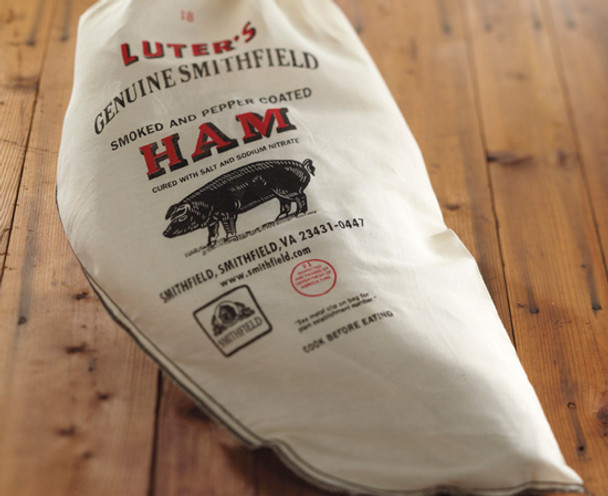Description
SMITHFIELD PRODUCTS ARE NO LONGER AVAILABLE ON THIS WEBSITE
Luter's Whole Genuine Smithfield Ham
Salt-Cured "Country Style" Artisan Ham
Aged and Smoked, Uncooked, Bone In
Comes In Cloth Sack
Ships frozen in a Sturdy Corrugated Box.
Whole Ham, 16 -19 lbs.
Price Includes UPS Standard Shipping
Hand-salted and dry cured from a centuries old recipe. Seasoned with black pepper and smoked over fires built from aged hardwoods, permeating the ham for up to12 months resulting in its distinctive, succulent flavor. Surface mold may appear but is in no way injurious (like the mold on fine cheeses). Preparation instructions for soaking and cooking methods included. Comes in a traditional cloth bag. Refrigerate upon receipt. Uncooked, 16-19 lbs. Serves about 36.
Use a stiff brush to remove surface mold if present. This mold is in no way injurious (like the mold on fine cheese). Aged hams, like aged cheeses, mold in the process
PLEASE NOTE these ham slices have been dry cured with SALT and should be sliced thin to enjoy the full country flavor. Genuine Smithfield Hams are very salty and are not appropriate for everyone's taste.
If you are also ordering items that do not include shipping, shipping charges and method will only apply to these items.
UPON RECEIPT:
COOKING:
Preparation prior to cooking - Uncooked Genuine Smithfield Hams require soaking before cooking since these hams are salt cured. The length of soaking time should be influenced by your taste for salt (longer soaking results in a milder ham). Genuine Smithfield Hams have the longest curing period and will be salty and dry by nature. Soak Genuine Smithfield Hams 36 hours or longer. Changing the water every several hours during soaking will aid in drawing salt from the ham. After soaking, wash ham thoroughly in warm water. Use a stiff brush to scrub ham thoroughly and remove all pepper and surface mold, if present. Mold is a common and natural occurrence on aged hams (just like fine aged cheeses), denotes proper curing, and does not affect the taste or quality. COOKING:
Preparation prior to cooking - Uncooked Genuine Smithfield Hams require soaking before cooking since these hams are salt cured. The length of soaking time should be influenced by your taste for salt (longer soaking results in a milder ham). Genuine Smithfield Hams have the longest curing period and will be salty and dry by nature. Soak Genuine Smithfield Hams 36 hours or longer. Changing the water every several hours during soaking will aid in drawing salt from the ham. After soaking, wash ham thoroughly in warm water. Use a stiff brush to scrub ham thoroughly and remove all pepper and surface mold, if present. Mold is a common and natural occurrence on aged hams (just like fine aged cheeses), denotes proper curing, and does not affect the taste or quality.
Oven Cooking - Wrap in heavy duty aluminum foil, forming a vessel with the bottom layer. Place in a large roasting pan for support. Add 4 to 5 cups of water within the foil and carefully join the edges of the aluminum foil making sure the edges are closed. Preheat oven to 300°F and bake approximately 3 hours or 20 minutes per pound. Using a meat thermometer, check for a 163°F internal temperature in the thickest part of the ham. Remove ham from oven when correct internal temperature is reached and let cool to room temperature for one hour. Remove skin and fat as desired.
Water Cooking – Place ham skin-side down in a roasting pan large enough to cover ham and fill with cool water. Bring water to 190°F (not quite simmering). Cook to 163°F degrees internal temperature (or about 25 minutes per pound), adding water to keep ham covered. Remove ham from water when correct internal temperature is reached and let cool to room temperature for one hour. Remove skin and fat as desired.
GLAZING & SEASONING:
If a sweet coating is desired, sprinkle the fat side with brown sugar and bread crumbs and bake in a 400°F oven until brown (approximately 15 minutes). Or to add your personal glaze choice, please follow the recipe or manufacturer's instructions for glaze preparation. No further seasoning is recommended. CARVING:
With ham on a flat surface, dressed side up, begin about two inches from the hock (or small end) and make the first cut straight down through to the bone. For each succeeding cut, slant the knife slightly and cut thinly towards the first straight cut (in the direction of the hock). Continue slicing thinly down to and partially around the bone. Decrease slant as the slices become larger, while keeping the slices thin. Eventually the bone formation will cause you to cut smaller slices at different angles. The key is to keep the slices thin! Be sure to keep the bone and remaining meat for seasoning. SERVING SUGGESTIONS:
Best served as the focus of a buffet, carving station, or pre-sliced for ease of serving. A savory complement to a poultry or seafood entrée. Perfect for biscuits, or chopped for salads and omelets. Use the bone and leftovers to season soups, beans, or vegetables. Delicious for breakfast, lunch, or dinner.
Best served as the focus of a buffet, carving station, or pre-sliced for ease of serving. A savory complement to a poultry or seafood entrée. Perfect for biscuits, or chopped for salads and omelets. Use the bone and leftovers to season soups, beans, or vegetables. Delicious for breakfast, lunch, or dinner.

